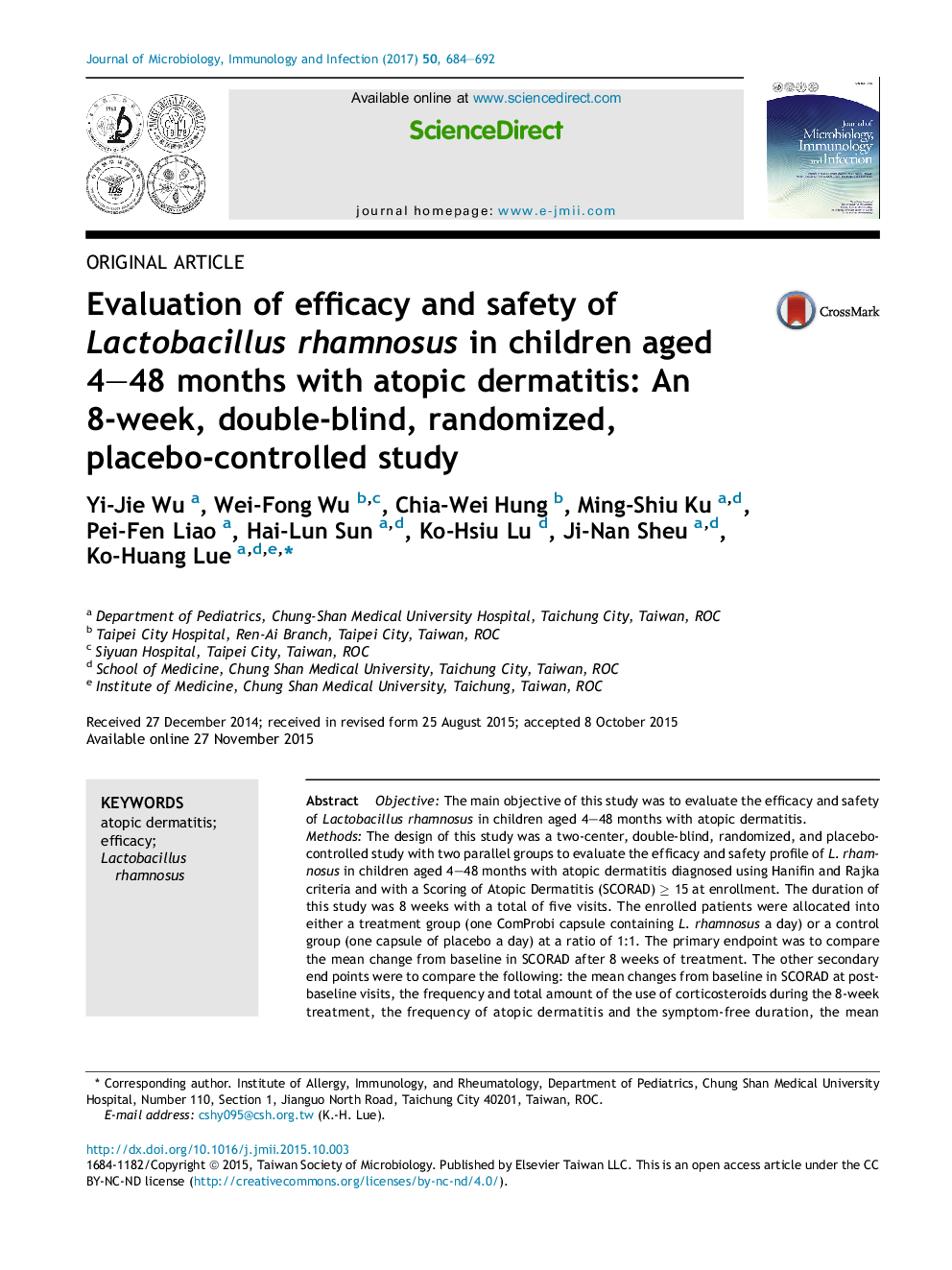| کد مقاله | کد نشریه | سال انتشار | مقاله انگلیسی | نسخه تمام متن |
|---|---|---|---|---|
| 5669118 | 1592438 | 2017 | 9 صفحه PDF | دانلود رایگان |

ObjectiveThe main objective of this study was to evaluate the efficacy and safety of Lactobacillus rhamnosus in children aged 4-48 months with atopic dermatitis.MethodsThe design of this study was a two-center, double-blind, randomized, and placebo-controlled study with two parallel groups to evaluate the efficacy and safety profile of L. rhamnosus in children aged 4-48 months with atopic dermatitis diagnosed using Hanifin and Rajka criteria and with a Scoring of Atopic Dermatitis (SCORAD) â¥Â 15 at enrollment. The duration of this study was 8 weeks with a total of five visits. The enrolled patients were allocated into either a treatment group (one ComProbi capsule containing L. rhamnosus a day) or a control group (one capsule of placebo a day) at a ratio of 1:1. The primary endpoint was to compare the mean change from baseline in SCORAD after 8 weeks of treatment. The other secondary end points were to compare the following: the mean changes from baseline in SCORAD at postbaseline visits, the frequency and total amount of the use of corticosteroids during the 8-week treatment, the frequency of atopic dermatitis and the symptom-free duration, the mean changes from baseline in Infant Dermatitis Quality of Life Questionnaire at Week 4 and Week 8, and the mean changes from baseline in the Dermatitis Family Impact Questionnaire at Week 4 and Week 8.ResultsThe mean changes in SCORAD from baseline at Week 8 was â21.69 ± 16.56 in the L. rhamnosus group and â12.35 ± 12.82 in the placebo group for the intent-to-treat population (p = 0.014). For the per-protocol population, the mean change of SCORAD from baseline was â23.20 ± 15.24 in the L. rhamnosus group and â12.35 ± 12.82 in the placebo group (p = 0.003). Significant differences were demonstrated between groups at Week 8 in intensity in the intent-to-treat population and per-protocol population. Throughout the period, the amount of topical corticosteroids used showed no difference between groups. No significant difference was noted in the overall symptom-free durations compared with the placebo group. Infant Dermatitis Quality of Life Questionnaires and Dermatitis Family Impact Questionnaires scores improved significantly at Week 4 and Week 8 but did not reach statistical significance. Adverse events were documented in 14/33 patients in the L. rhamnosus group (42.42%, 35 events) and in 15/33 placebo patients (45.45%, 37 events).ConclusionsThe results of this study indicated that L. rhamnosus was effective in decreasing symptoms of atopic dermatitis after an 8-week treatment by comparing the mean change of SCORAD from baseline with a placebo (p < 0.05). The reduction in SCORAD resulted from a consistent decrease in all components of SCORAD. Patients who took L. rhamnosus for 8 weeks expressed less SCORAD in the three components: area of affected skin, intensity of atopic dermatitis, and patient symptoms, with a significant decrease in the mean change of intensity from baseline compared with placebo.
Journal: Journal of Microbiology, Immunology and Infection - Volume 50, Issue 5, October 2017, Pages 684-692